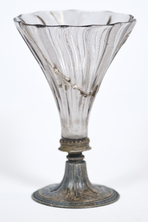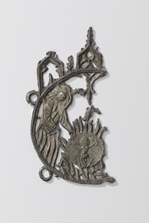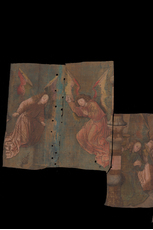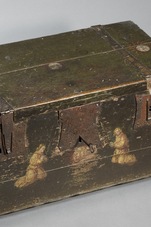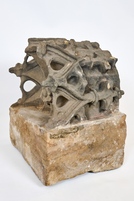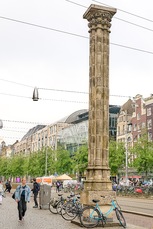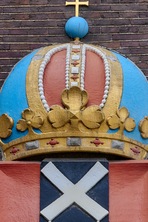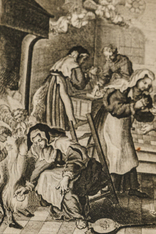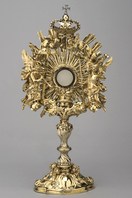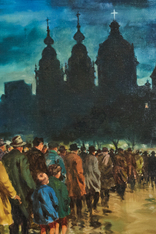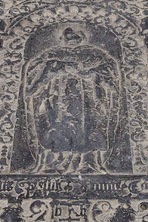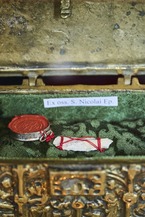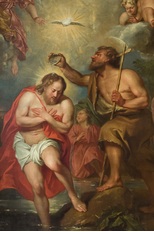1. Three Nicholas churches
Bridge Korte Niezel
From the museum we walk to the bridge that connects the Korte (short) and Lange (long) Niezel and turn around. If we look to the left we see the Oude Kerk, diagonally to the right in front of us the former clandestine church Het Hert (now Museum Our Lord in the Attic) and on the far right the Nicholas Basilica. These churches are also called the three Nicholas churches. In a nutshell, they tell the religious history of Amsterdam.
In the Middle Ages, the Oude Kerk was dedicated to Saint Nicholas, the patron saint of Amsterdam. It is a Catholic church. When in 1578 the city council of Amsterdam fell into Protestant hands, all expressions of the Catholic faith were banned and the churches, chapels and monasteries were confiscated. The St. Nicholas Church, also called the Old Church at that time, became a Protestant church. This means that from now on the Catholic citizens will have to profess their faith in so-called clandestine or hidden churches that are not recognizable as churches from the public road.
This is also the case for the hidden church Het Hert. The fact that in 1661-1663 a complete Catholic church was built and furnished on the upper floors of an average canal house is not visible from the street. In the Catholic tradition, this church has always been connected to the old St. Nicholas Church. In the 19th century — when all faiths were given equal rights and the Catholic clandestine churches became official parishes again — it was inevitable that Het Hert would be called the Sint Nicolaasparochie-binnen-de-Veste. Until 1887, when the large, new Nicholas Church was consecrated on 7 February. There we end our walk. So more about the Nicholas Basilica later.
2. Oude Kerk (Old Church)
Oudekerksplein
We walk on to the Oude Kerk, the oldest church in Amsterdam, consecrated as early as 1306 by the bishop of Utrecht as St. Nicholas Church. The church plays an important role in our story about the Miracle of Amsterdam. It is a priest from the Oude Kerk who is going to collect the host from the sick man's house. According to some stories, the host returns to the fireplace in the Kalverstraat three times. The last time, the miracle host will be brought to the Oude Kerk in a festive procession, this time with the intention of building a special chapel on the site of the miracle.
Since 1578, the Oude Kerk has been a Protestant church. Every week on Sunday morning, worship is celebrated here and there is a vespers in the evening. The church is also a museum where contemporary artists create site-specific artworks. In the church, the traces of the Catholic and Protestant history of the building are clearly visible.
Do you want to know more about the last pastor of the Oude Kerk?
3. Sint Pietersgasthuis (Saint Peters Guest House)
Nes 60
We continue on the Oudezijds Voorburgwal, pass the Damstraat, turn right into the Sint Pieterspoortsteeg and then turn left onto the Nes. We are still walking on the old side of the Amstel, now the Damrak and the Rokin. In the Middle Ages, there were many monasteries here, such as the Old Nunnery, the Cellebroedersklooster and the St. Barbara Monastery. The names of the alleys remind us of this world of Catholic brothers and sisters.
Pilgrimage to a holy place is an important expression of faith at that time. Because of the Miracle, Amsterdam is a popular place of pilgrimage. Pilgrims visit the Heilige Stede and usually stay in the city for three days. They sleep in specially equipped dormitories called 'baaierds' or in guest houses such as the Sint Pietersgasthuis, located between the Amstel, the Grimburgwal and the Kloveniersburgwal.
In 1988 a special pilgrim pin was found in this area. It is a unique specimen because it has an image of the Miracle on it. We do not know whether the owner of the pin slept in the hospital, but we do know that the Heilige Stede was visited. Around popular shrines there is a lot of trade in food and drink and in pins that can be applied to the hat or clothing. Pilgrims take them with them as a reminder and as proof of their visit to the shrine. We know from Henk Schiffmacher, the famous Amsterdam tattoo artist, that pilgrims also get a tattoo out of fear of having their pin stolen.
Curious about the found pilgrim badge?
4. Heilige Stede (Holy Stead)
Opposite Rokin 78
We walk through the Cellebroerssteeg and arrive at the Rokin. On the other side of the street, somewhat to the left, we see the site of the Heilige Stede. Actually, we are looking at a modern haunted house about the dark history of Amsterdam. The Chapel of the Holy Stead was built here in 1346-47. Fire plays an important role in the history of the Miracle. During the major city fires of 1421 and 1452, the chapel was largely destroyed, but the miraculous host remained remarkably intact. Every year there is a sacrament procession and a festive market. After the Alteration in 1578, the Catholic interior was destroyed. The chapel became a Protestant church and from that time on it was called Nieuwezijds Kapel. The beautiful monstrance and the host shown in it disappear without a trace.
You can read more about the Miracle of Amsterdam, the host, the famous canvases by Jacob van Oostsanen, the fate of a coffin in which the host is said to have been stored, miracles and medieval processions in the following stories.
The Miracle canvases by Jacob van Oostsanen
The fate of the Miracle coffin
5. Miracle column
Rokin 78
We now cross safely via the zebra crossing at the metro station, walk to the right on the other side and see the so-called Miracle Column in front of us. It is built from the debris of the old Heilige Stede. The building, which survived two city fires and was in use for more than five centuries, was demolished in 1908. This to the great sorrow of many Catholic Amsterdammers. Even though the building has been used for Protestant worship for centuries, it still has an emotional value as a place where the Miracle took place. In 1912, architect Christiaan Posthumus Meyes built a smaller church on the same site with shopping facilities around it: the new Nieuwezijds Kapel. Since 2007, this building no longer has a religious function. With the demolition of the former Heilige Stede, the stones disappear everywhere and nowhere. They are reused, but also sold at antique markets or collected as relics. This column was built up in 1988 from some of the building fragments that went to the stray.
Read more about the building fragments
Read more about the Miracle Column
6. Heilige Hoek (Holy Corner)
Corner Kalverstraat – Wijde Kapelsteeg
We walk into the Wijde Kapelsteeg. On the left corner of the alley and the Kalverstraat is a memorial stone, in memory of the fireplace in the house of the sick man. That is why this place is called the Holy Corner. The Heilige Stede was more or less built around the hearth in 1346-47.
Diagonally opposite the Holy Corner we see the old gate of the Burgerweeshuis, with the crown of Emperor Maximilian above the gate. Amsterdam was allowed to add this crown to its coat of arms after Maximilian had miraculously recovered from severe fevers and had visited the Holy Stead.
Do you want to know more about Emperor Maximilian and his crown?
7. Beguinage Chapel
Begijnhof
We walk via the Begijnensteeg and the filled-in Begijnensloot to the Beguinage and the Beguinage Chapel. Two places of silence and contemplation in the busy city. The Beguinage Chapel is a former clandestine church. Here, the memory of the Miracle of Amsterdam has been kept alive for centuries. In the clandestine church period, pastor Leonardus Marius was an authoritative Catholic priest. He senses well how important the memory of the Miracle is for the Catholic Amsterdammers who have to profess their faith in hidden churches and hide all the outward characteristics of their faith. Marius writes a book in which he defends the belief in the miraculous events of 1345 and the Catholic faith. The book contains prints that depict the miracle. In the Beguinage Chapel, references and images of the Miracle can be found in a mural, in the stained glass windows and on objects set up in the space to the left of the altar. The chapel is not a museum, but a religious place where people pray in silence and celebrate mass.
Curious about Leonardus Marius and his book?
A music company has kept the memory of the Miracle alive
8. Silent Walk
Corner Kalverstraat – Wijde Kapelsteeg
We walk back to the Holy Corner. Every year in the night from Saturday to Sunday, after March 15, the Silent Walk starts here. Thousands of people walk in silence the ancient route of the medieval procession in honor of the Miracle. There is a difference, however. In the Middle Ages, it is a parade with exuberant clothing and festive music. Now there is no religious or other outward show and there is silence. The fact that the old procession route can be walked again is thanks to the Amsterdammers Joseph Lousbergh and Carel Elsenburg. In 1880 they came into possession of a document in which the old route is described in great detail. They decide to walk the original route every year. Soon others joined and a tradition arose that attracted Catholics from all over the country. Het Gezelschap van de Stille Omgang (The Fellowship of the Silent Walk) keeps this tradition alive to this day.
We followed the old procession route through the Kalverstraat towards the Dam. On a busy Saturday afternoon, the atmosphere and devotion of the Silent Walk is not really palpable. That argues in favor of walking along at night. The Silent Walk has long since ceased to be an exclusively Catholic affair. Everyone is welcome to join the walk.
Do you want to know more about the Silent Walk?
9. Nieuwe Kerk (New Church)
Dam Square
We walk to Dam Square. Next to the palace is the Nieuwe Kerk, dedicated in 1409 to the Blessed Virgin Mary and Saint Catherine. It is the second parish church in Amsterdam. Due to the growing population, the city is expanding on this, new, side of the Amstel. The Oude Kerk is becoming too small and the residents of the new side also need their own church. Just like the Holy Stead, the Nieuwe Kerk was also damaged by the city fires of 1421 and 1452.
In 1578, after the Alteration, Amsterdam became a Protestant city. The Nieuwe Kerk is stripped of all Catholic elements, such as altars, statues, paintings and family chapels. It is therefore special that a tombstone of a priest from a distinguished family has been preserved.
Who was this sixteenth-century priest and crusader Claes Boelens den Otter?
10. Nicolaasbasiliek (Saint Nicholas Basilica)
Prins Hendrikkade
We continue the old procession route over the Nieuwendijk to the Prins Hendrikkade and turn right in the direction of the basilica of Saint Nicholas. The imposing, visible church is the complete opposite of the hidden church Het Hert, also called Our Lord in the Attic or Sint Nicolaas-binnen-de-Veste. The inauguration of the new church is undoubtedly a special event. In 1887, the parishioners left Our Lord in the Attic in a festive procession and, together with Father Van Born, brought the Blessed Sacrament and all liturgical objects to the Nicholas Church.
The memory of the Miracle of Amsterdam is also kept alive in the Nicholas Basilica. The story is beautifully depicted by the painter Jan Dunselman, who also painted all the important events in the life of Saint Nicholas. Saint Nicholas is the patron saint of Amsterdam.
Read more about Nicholas, the miracles he performed and his relic that is present in the basilica
On March 8, in the jubilee year 2025, the Nicholas Basilica was elevated to co-cathedral in the diocese of Haarlem-Amsterdam.
11. Museum Ons’ Lieve Heer op Solder
Oudezijds Voorburgwal 38-40
There are now two possibilities: continue the old procession route via the Warmoesstraat and the Nes to the former Heilige Stede or walk up the Oudezijds Voorburgwal and drink coffee in Museum Our Lord in the Attic. A visit to the 17th-century canal house and the clandestine church in the attic is of course more than worthwhile.
What does the special altarpiece in the church have to do with the ransom of Christian slaves?



